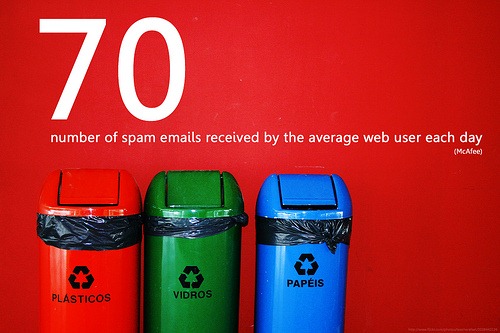Sometimes, it can seem as if the amount of email we receive is growing exponentially. Thanks to its speed and ease of use, email has quickly taken over the printed word as the #1 means of businesses communications. And technology continues to drop in price and become more accessible all over the world, this trend will only continue to grow in the future. As an entrepreneur, this means that your profitability will be greatly determined by how efficiently you manage your inbound flow of email. You need a system that will allow you to get the maximum amount of work done, while minimizing the amount of time you spend on non-productive tasks.
Img Credit: http://www.flickr.com/photos/will-lion/2629598996/
And since your email account is the central hub of your workflow, this would be a good place to start looking for efficiencies.
One interesting technique for effective email management was designed by the Microsoft Corporation, and it’s called the 4D Method. Although, it was originally intended for users of MS Outlook, this technique can easily be adapted for just about any other client or web-based email account.
Make an immediate decision on how to handle every new message
Try to imagine all the times you’ve had to re-open, re-read, and re-close the same email multiple times. It may not seem like much, but these unnecessarily repetitive actions are eating up a lot of your productive time and derailing your train of thought at work.
It’s a lot of distraction, with very little benefit in return.
In order to save time and maximize the productivity of your email usage, your goal should be to read an email message only once before taking action on it. This means that you must decide, early on, where to put your emails and what to do with them.
When a new email comes in, you must immediately decide whether to: email archiving and online backup software services for businesses of all sizes.
- Delete it
- Do it
- Delegate it
- Defer it
Those are the 4 Ds of the 4D Method.
Option 1: Delete the email
Time management experts estimate that roughly half of your (non-spam) inbound email can be immediately deleted. This suggestion can make a lot of people feel uncomfortable. “Deleting” sounds so final… especially when there’s a chance that you may need it again at a later time.
This hesitation is perfectly natural. But you must to separate yourself from your emotions and ask yourself objectively “How much of this information will I actually ever need again?”
If you are – in fact – using a large portion of the emails that you retain, this is a good sign that your current system is working well for you. However, most people are keeping much more historical email than they will ever need.
Ask yourself the following questions when deciding if an email needs to be deleted:
- Is this message important for a project that I’m currently working on? If the answer is NO, then you should delete it immediately. Why keep it if you don’t need it.
- Can I easily get this information from somewhere else? If the answer is YES, then this message shouldn’t be in your Inbox. Delete.
- Will I require any of this information within the next 6-12 months? If the answer is NO, then delete the email.
- Am I required to keep this information on file? If the answer is NO, then get rid of it. But if the answer is YES, then you should probably keep it in a better place than your Inbox.
Option 2: Do it right away
If you’ve determined that the email in question isn’t worthy of deletion, then you must ask “What do I need to do with this email now?” & “Is this something I can do in about a minute?”
If it’s something this simple that can be completed in about a minute, then it doesn’t really make sense to file it away or close it.
If you try this technique, I think you will be surprised by how much work you can quickly get done. Once you get good, you’ll likely be able to handle about 30% of your email in this manner.
Option 3: Delegate the task to someone else
If you find it impractical to delete the email or do the work immediately, then try to see if you can delegate the task to another person.
If this is the case, try to delegate the work immediately. After that, delete the message or move it to a “reference” folder in case you need it again in the future.
Option 4: Defer it until later
If this email can’t be Deleted, Done or Delegated, then that must mean that
- some sort of action is necessary,
- which will take more than a minute…
- and that you’re the only person who can do it.
If you’ve been applying this technique properly, you should find that only about 1 in 10 emails fall into this category.
At this point, you need to either make it into a task or appointment on your schedule.
This can be easily done in Outlook by dragging any email message onto your task list (in order to create a new task) or by dragging the message over to your calendar (to make an appointment).
Make this a daily habit
If you make a habit of using the 4D Method every day, you’ll find that you’re able to handle large amounts of email very quickly and easily. You’ll be more productive and have more free time, with less effort.
In order to maximize your efficiency even further, you should exercise a bit of self-control and check your email less often. No more than once or twice per day. (It’s very rare that an email will ever be so urgent that it can’t wait a few hours)
In many cases, people who receive anywhere from 50-100 emails per day can get it all handled within less than an hour.
According to a recent study, most corporate email will usually consist of the following:
- 50% can be filed or deleted immediately
- 30% can be completed or delegated within a few minutes
- 20% can be set aside as a “To Do” list item or an appointment for later
Although this method requires a bit of discipline on your part, over time it will begin to feel much more natural and effortless.
This is a guest Article by Patrick Jobin from Storage Pipe: Storagepipe Solutions offers email archiving and online backup software services for businesses of all sizes.







Hi,
In case you or some of your readers are interested, I’ve created an add-in that incorporates project management into Microsoft Outlook.
All of your project base emails, files, contacts, tasks and appointments are managed in a central, easy to use location.
You can find more information on our web-site: Outlook Project Management
Kevin